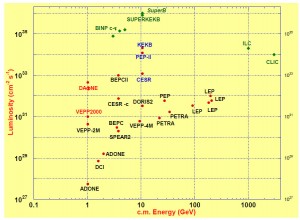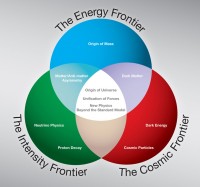
Peak luminosity of electron-positron colliders. The Super B will be at the intensity frontier, shown at the top of the graph, while the ILC and CLIC are at the energy frontier, shown on the right side.
Happy New Year! This is my first column of 2011 and I am very pleased to begin the year by reporting on the significant new investment in particle physics by the Italian government. The Italian Ministry for Education, University and Research has announced the funding of the proposed €400-million Super B project of the Italian National Institute of Nuclear Physics (INFN). The present plan is to site the machine at or near the Frascati Laboratory and to reuse magnets and other apparatuses from the PEP-II accelerator and the BABAR detector at SLAC in the US, both keeping costs down and enabling a rapid construction schedule, perhaps as short as five years.
Particle physics is often described as having three complementary frontiers, which was emphasised in the US Department of Energy’s HEPAP P5 report on future directions for the American high-energy physics programme. The HEP community has been particularly productive at the intensity frontier over the last two decades, especially with the discovery of neutrino oscillations and subsequent follow-up experiments, as well as with the extensive B physics results from the B factories. B physics results include the first observations of CP violation outside the K meson system and the measurements of the Cabibbo-Kobayashi-Maskawa (CKM) parameters provided experimental verification for the 2008 Nobel Prize in physics awarded to Makoto Kobayashi and Toshihide Maskawa.
I reported in July 2010 that Japan had approved the initial funding for SuperKEKB, an upgrade to the present Japanese B factory toward their version of a very high-luminosity machine. Now, with the Italian announcement, there will be two efforts worldwide to build such high-luminosity machines, following the precedent of having two B factories, SLAC and KEK. In that case, the competition and variation of approaches proved to be extremely valuable, and this should again be true for the next-generation higher-luminosity machines.
On the other hand, one might reasonably wonder whether such duplications are optimal for a field with limited potential resources to realise its many exciting ambitions for future projects. These include long baseline neutrino initiatives, dark energy and dark matter experiments, upgrades to the LHC and, of course, a future high-energy lepton collider. In spite of the difficulty of realising all of these ambitious endeavours, we must recognise that high-energy physics research and facilities are undertaken by individual countries (or regions), except for projects so large that they must be global (like the ILC). Many factors beyond balancing the global particle physics programme go into determining which large science projects are undertaken. We must accept these realities and work hard to realise our ambitions one by one. The new Super B project in Italy represents a big step towards assuring a rich future at one of our three frontiers of particle physics.

The DAFNE performances of its four experiments, validating improvements as a result of the large-angle collision scheme
Advances in accelerator physics have enabled the design of these ambitious next-generation machines. Pantaleo Raimondi of INFN’s Frascati Laboratory proposed the key ideas that could enable such high luminosities, in particular the “crab waist” sextupole tranformation. The general idea is to collide the electron and positron beams at a large angle, reducing the disruption of the beams at the collision point. However, to accomplish high luminosities in such a scheme, several new tricks are employed involving tilting and rotating the beams, in order to make the required small focus possible. Experimental verification has been provided from experiments at the DAΦNE accelerator at Frascati.
Funding of large projects is a very complicated process and it is not always easy to determine when (if ever) firm government commitments have been made. There are clearly many steps still ahead for the Italian Super B project, including the selection of the site, producing a detailed technical design report and developing international collaborations and commitments, among others. Nevertheless, the recent action by the Italian government is a very encouraging and big step towards a real project. Roberto Petronzio, president of INFN, has said of this action, “I’m quite confident it’s the real beginning of the project.”
I heartily congratulate our colleagues who have worked so hard towards making the Italian Super B project a reality.




Recent Comments